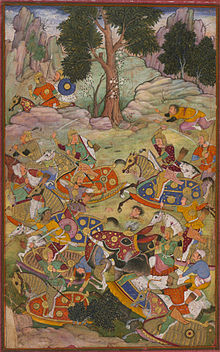Battle of Panipat (1526)
| First Battle of Panipat | |||||||||
|---|---|---|---|---|---|---|---|---|---|
| Part of Mughal conquests | |||||||||
 The battle of Panipat and the death of Sultan Ibrāhīm |
|||||||||
|
|||||||||
| Belligerents | |||||||||
| Babur | Lodi dynasty and Afghans | ||||||||
| Commanders and leaders | |||||||||
| Babur Humayun Chin Timur Khan Ustad Ali Quli Mustafa Rumi Asad Malik Hast Raja Sanghar Ali Khan |
Ibrahim Lodi † Vikramjit † |
||||||||
| Strength | |||||||||
| 12,000 Mughals Field artillery |
100,000 50,000 (Afghan sources) 100 war elephants |
||||||||
| Casualties and losses | |||||||||
| Few | 15,000-20,000 | ||||||||
The First Battle of Panipat, on 21 April 1526, was fought between the invading forces of Babur and the Lodi Empire. It took place in north India and marked the beginning of the Mughal Empire. This was one of the earliest battles involving gunpowder firearms and field artillery in India.
After losing Samarkand for the third time, Babur gave attention to conquer India as he reached the banks of the Chenab in 1519. Until 1524, his aim was to only expand his rule to Punjab, mainly to fulfil his ancestor Timur's legacy, since it used to be part of his empire. At the time parts of north India were under the rule of Ibrahim Lodi of the Lodi dynasty, but the empire was crumbling and there were many defectors. He received invitations from Daulat Khan Lodi, Governor of Punjab and Ala-ud-Din, uncle of Ibrahim. He sent an ambassador to Ibrahim, claiming himself the rightful heir to the throne of the country, however the ambassador was detained at Lahore and released months later.
Babur started for Lahore, Punjab, in 1524 but found that Daulat Khan Lodi had been driven out by forces sent by Ibrahim Lodi. When Babur arrived at Lahore, the Lodi army marched out and his army was routed. In response, Babur burned Lahore for two days, then marched to Dipalpur, placing Alam Khan, another rebel uncle of Lodi's, as governor. Alam Khan was quickly overthrown and fled to Kabul. In response, Babur supplied Alam Khan with troops who later joined up with Daulat Khan Lodi and together with about 30,000 troops, they besieged Ibrahim Lodi at Delhi. He defeated them and drove off Alam's army and Babur realized Lodi would not allow him to occupy the Punjab.
Hearing of the size of Ibrahim's army, Babur secured his right flank against the city of Panipat, while digging a trench covered with tree branches to secure his left flank. In the center, he placed 700 carts tied together with ropes. Between every two carts there were breastworks for his matchlockmen. Babur also ensured there was enough space for his cavalry to charge between these carts.
When Ibrahim's army arrived, he found the approach to Babur's army too narrow to attack. While Ibrahim redeployed his forces to allow for the narrower front, Babur quickly took advantage of the situation to flank (tulghuma) the Lodi army. Many of Ibrahim's troops, were unable to get into action and as the battle turned against Ibrahim, they fled. Faced with musket fire, cannon fire and cavalry attacks from all sides, Ibrahim Lodi fought and died with 6,000 of his remaining troops.
...
Wikipedia
